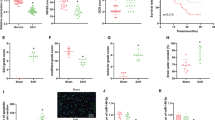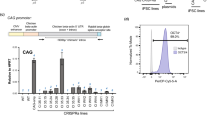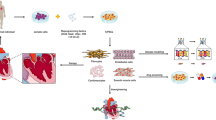Abstract
Embryonic hypoxia/ischemia is a major cause of a poor fetal outcome and future neonatal and adult handicaps. However, biochemical cellular events in mouse embryonic stem (mES) cells during hypoxia remains unclear. This study investigated the underlying mechanism of apoptosis in mES cells under CoCl2-induced hypoxic/ischemic conditions. CoCl2 enhanced the expression of hypoxia-inducible factor-1α (HIF-1α) and the accumulation of reactive oxygen species in mES cells. The CoCl2-treated mES cells showed a decrease in cell viability as well as typical apoptotic changes, cell shrinkage, chromatin condensation, and nuclear fragmentation and an extended G2/M phase of the cell cycle. CoCl2 augmented the release of cytochrome c into the cytosol from the mitochondria with a concomitant loss of the mitochondrial transmembrane potential (ΔΨm) and upregulated the voltage-dependent anion channel. In addition, CoCl2-induced caspase-3, -8, and -9 activation and upregulation of p53 level, whereas downregulated Bcl-2 and Bcl-xL, a member of the anti-apoptotic Bcl-2 family in mES cells. Furthermore, CoCl2 led to the upregulation of Fas and Fas-ligand, which are the death receptor assemblies, as well as the cleavage of Bid in mES cells. These results suggest that CoCl2 induces apoptosis through both mitochondria- and death receptor-mediated pathways that are regulated by the Bcl-2 family in mES cells.






Similar content being viewed by others
References
Kitagawa Y, Suzuki K, Yoneda A, Watanabe T (2004) Effects of oxygen concentration and antioxidants on the in vitro developmental ability, production of reactive oxygen species (ROS), and DNA fragmentation in porcine embryos. Theriogenology 62:1186–1197
Agarwal A, Gupta S, Sharma RK (2005) Role of oxidative stress in female reproduction. Reprod Biol Endocrinol 3:28–49
Pearlstone M, Baxi L (1993) Subchorionic hematoma: a review. Obstet Gynecol Surv 48:65–68
Granger JP, Alexander BT, Llinas MT, Bennett WA, Khalil RA (2002) Pathophysiology of preeclampsia: linking placental ischemia/hypoxia with microvascular dysfunction. Microcirculation 9:147–160
Lee CN, Cheng WF, Chang MC, Su YN, Chen CA, Hsieh FJ (2005) Hypoxia-induced apoptosis in endothelial cells and embryonic stem cells. Apoptosis 10(4):887–894
Kim MH, Kim MO, Heo JS, Kim JS, Han HJ (2008) Acetylcholine inhibits long-term hypoxia-induced apoptosis by suppressing the oxidative stress-mediated MAPKs activation as well as regulation of Bcl-2, c-IAPs, and caspase-3 in mouse embryonic stem cells. Apoptosis 13:295–304
Cao YJ, Shibata T, Rainov NG (2001) Hypoxia-inducible transgene expression in differentiated human NT2 N neurons-a cell culture model for gene therapy of postischemic neuronal loss. Gene Ther 8:1357–1362
Wang GX, Li GR, Wang YD, Yang TS, Ouyang YB (2001) Characterization of neuronal cell death in normal and diabetic rats following experimental focal cerebral ischemia. Life Sci 69:2801–2810
Brook FA, Gardner RL (1997) The origin and efficient derivation of embryonic stem cells in the mouse. Proc Natl Acad Sci USA 94:5709–5712
Chambers I (2004) The molecular basis of pluripotency in mouse embryonic stem cells. Cloning Stem Cells 6:386–391
O’Shea KS (1999) Embryonic stem cell models of development. Anat Rec 257:32–41
Niwa H (2001) Molecular mechanism to maintain stem cell renewal of ES cells. Cell Struct Funct 26:137–148
Prelle K, Zink N, Wolf E (2002) Pluripotent stem cells-model of embryonic development, tool for gene targeting, and basis of cell therapy. Anat Histol Embryol 31:169–186
Han HJ, Heo JS, Lee YJ (2006) Estradiol-17β stimulates proliferation of mouse embryonic stem cells: involvement of MAPKs and CDKs as well as protooncogenes. Am J Physiol Cell Physiol 290:C1067–C1075
Heo JS, Lee YJ, Han HJ (2006) EGF stimulates proliferation of mouse embryonic stem cells: involvement of Ca2+ influx and p44/42 MAPKs. Am J Physiol Cell Physiol 290:C123–C133
Zou W, Yan M, Xu W, Huo H, Sun L, Zheng Z, Liu X (2001) Cobalt chloride induces PC12 cells apoptosis through reactive oxygen species and accompanied by AP-1 activation. J Neurosci Res 64:646–653
Jung JY, Kim WJ (2004) Involvement of mitochondrial- and Fas-mediated dual mechanism in CoCl2-induced apoptosis of rat PC12 cells. Neurosci Lett 371:85–90
Zou W, Zeng J, Zhuo M, Xu W, Sun L, Wang J, Liu X (2002) Involvement of caspase-3 and p38 mitogen-activated protein kinase in cobalt chloride induced apoptosis in PC12 cells. J Neurosci Res 28:2135–2140
Moritz W, Meier F, Stroka DM, Giuliani M, Kugelmeier P, Nett PC, Lehmann R, Candinas D, Gassmann M, Weber M (2002) Apoptosis in hypoxic human pancreatic islets correlates with HIF-1 alpha expression. FASEB J 16:745–747
Dhalla NS, Temsah RM, Netticadan T (2000) Role of oxidative stress in cardiovascular diseases. J Hypertens 18:655–673
Li C, Jackson RM (2002) Reactive species mechanisms of cellular hypoxia-reoxygenation injury. Am J Physiol Cell Physiol 282:C227–C241
Duranteau J, Chandel NS, Kulisz A, Shao Z, Schumacker PT (1998) Intracellular signaling by reactive oxygen species during hypoxia in cardiomyocytes. J Biol Chem 273:11619–11624
Hensley K, Robinson KA, Gabbita SP, Salsman S, Floyd RA (2000) Reactive oxygen species, cell signaling, and cell injury. Free Radic Biol Med 28:1456–1462
Lennon SV, Martin SJ, Cotter TG (1991) Dose-dependent induction of apoptosis in human tumour cell lines by widely diverging stimuli. Cell Prolif 24(2):203–214
Covello KL, Kehler J, Yu H, Gordan JD, Arsham AM, Hu CJ, Labosky PA, Simon MC, Keith B (2006) HIF-2alpha regulates Oct-4: effects of hypoxia on stem cell function, embryonic development, and tumor growth. Genes Dev 20:557–570
Chen X, Tian Y, Yao L, Zhang J, Liu Y (2009) Hypoxia stimulates proliferation of rat neural stem cells with influence on the expression of cyclin D1 and c-Jun N-terminal protein kinase signaling pathway in vitro. Neuroscience 165:705–714
Guo M, Song LP, Jiang Y, Liu W, Yu Y, Chen GQ (2006) Hypoxia-mimetic agents desferrioxamine and cobalt chloride induce leukemic cell apoptosis through different hypoxia-inducible factor-1α independent mechanisms. Apoptosis 11:67–77
Singla DK, Singla RD, McDonald DE (2008) Factors released from embryonic stem cells inhibit apoptosis in H9c2 cells through PI3 K/Akt but not ERK pathway. Am J Physiol Heart Circ Physiol 295(2):H907–H913
Earnshaw WC, Marins LM, Kaufmann SH (1999) Mammalian caspases: structure, activation, substrates, and functions during apoptosis. Annu Rev Biochem 68:383–424
Bal-Price A, Brown GC (2000) Nitric-oxide-induced necrosis and apoptosis in PC12 cells mediated by mitochondria. J Neurochem 75:1455–1464
Leist M, Single B, Naumann H, Fava E, Simon B, Kuhnle S, Nicotera P (1999) Nitric oxide inhibits execution of apoptosis at two distinct ATP-dependent steps upstream and downstream of mitochondrial cytochrome c release. Biochem Biophys Res Commun 258:215–221
Herrera B, Alvarez AM, Sanchez A, Fernandez M, Roncero C, Benito M, Fabregat I (2001) Reactive oxygen species (ROS) mediates the mitochondrial-dependent apoptosis induced by transforming growth factor (beta) in fetal hepatocytes. FASEB J 15:741–751
Fleury C, Mignotte B, Vayssiere JL (2002) Mitochondrial reactive oxygen species in cell death signaling. Biochimie 84:131–141
Veenman L, Shandalov Y, Gavish M (2008) VDAC activation by the 18 kDa translocator protein (TSPO), implications for apoptosis. J Bioenerg Biomembr 40(3):199–205
Howard S, Bottino C, Brooke S, Cheng E, Giffard RG, Sapolsky R (2002) Neuroprotective effects of Bcl-2 overexpression in hippocampal cultures: interactions with pathways of oxidative damage. J Neurochem 83:914–923
Gottlieb E, Vander Heiden MG, Thompson CB (2000) Bcl-xl prevents the initial decrease in mitochondrial membrane potential and subsequent reactive oxygen species production during tumor necrosis factor alpha-induced apoptosis. Mol Cell Biol 20:5680–5689
Starkov A, Polster B, Fiskum G (2002) Regulation of hydrogen peroxide production by brain mitochondria by calcium and Bax. J Neurochem 83:220–228
Facchinetti F, Furegato S, Terrazzino S, Leon A (2002) H2O2 induces upregulation of Fas and Fas ligand expression in NGF-differentiated HGF cells: modulation by cAMP. J Neurosci Res 69:178–188
Acknowledgments
This research was supported by Basic Science Research Program through the National Research Foundation of Korea (NRF) funded by the Ministry of Education, Science and Technology (2009-0075373 and 2010-0006901) and was supported by the National Research Foundation of Korea (NRF) Grants funded by the Korea government (MEST) (2011-0030761 and 2011-0029663).
Author information
Authors and Affiliations
Corresponding authors
Rights and permissions
About this article
Cite this article
Lee, JH., Choi, SH., Baek, MW. et al. CoCl2 induces apoptosis through the mitochondria- and death receptor-mediated pathway in the mouse embryonic stem cells. Mol Cell Biochem 379, 133–140 (2013). https://doi.org/10.1007/s11010-013-1635-5
Received:
Accepted:
Published:
Issue Date:
DOI: https://doi.org/10.1007/s11010-013-1635-5




